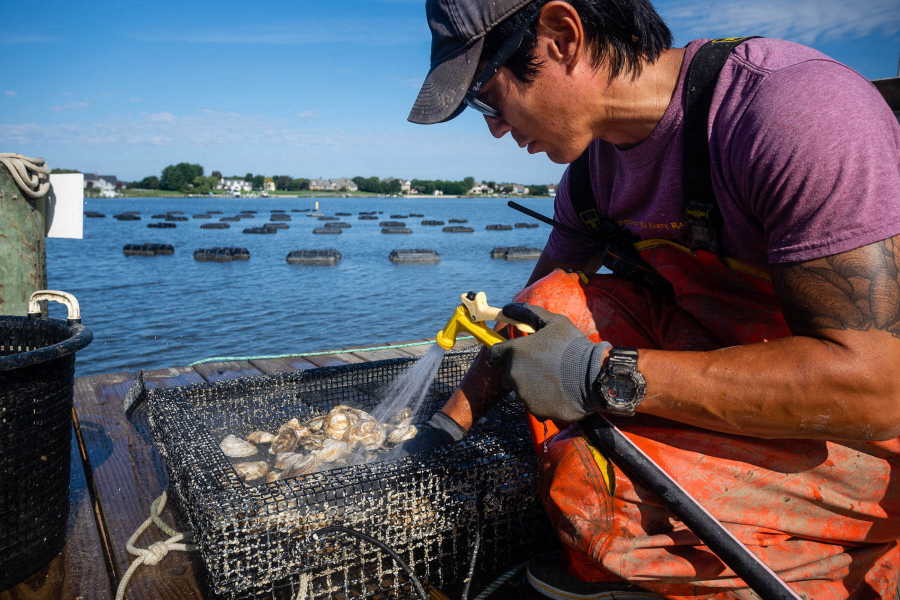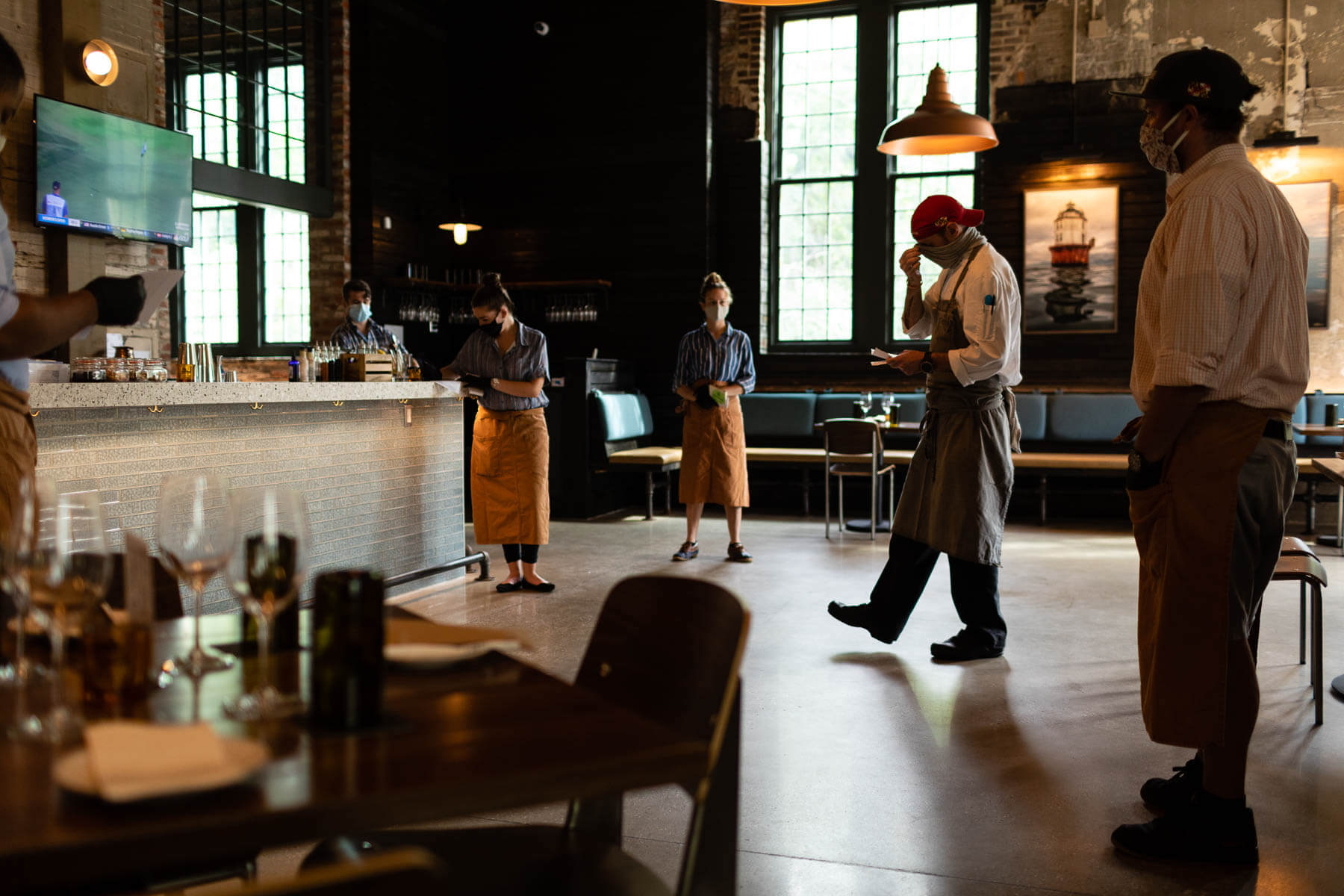The highs and lows of Maryland’s oyster aquaculture industry

Over the past decade, oyster farming in the Chesapeake Bay and its tributaries has become one of the fastest-growing industries in Maryland. Like other byproducts of the farm-to-table movement, the industry fills a consumer demand for locally-sourced eats. Oyster bars, oyster festivals and oysters at brunch are now a common sight in the state, while the region’s top businesses have become something of a household name for those adventurous enough to slurp down the bivalve.
Oyster farming, or oyster aquaculture, involves planting and cultivating oysters, as opposed to harvesting them in the wild. Oyster farmers privately lease acres of submerged land or water columns to raise their oyster stock, and either sell them to restaurants and seafood companies, or offer them at their own dining venue. The people who grow these oysters for a living come from various walks of life—some grew up in coastal communities and are from a long line of watermen, while others ditched their desk jobs in the city to pursue a different path.
As you can imagine, in 2020, the budding Chesapeake Bay industry is deeply suffering due to restrictions put in place to limit the spread of the coronavirus. Restaurant sales are significantly lower, and the price of oysters continuously threatens to drop. On top of these marketplace detriments, prospective and current oyster farmers face long-standing barriers to entering the market and expanding their businesses. As the challenges mount for aquaculture farmers, it’s more important than ever to examine the benefits that the industry brings to our region, and what can be done to help.
A booming local business with environmental benefits
Ever since Maryland passed a bill opening up 600,000 acres of the state’s portion of the Bay for oyster farming, the industry has steadily-grown, with revenue and jobs opportunities at its coattails.
According to a recent economic analysis commissioned by the Chesapeake Bay Foundation, the number of bushels harvested through Maryland’s private aquaculture operations grew from less than 1% of the total bushels harvested from the wild fishery in 2012 to 42% of that total in 2018. In that year, despite record rainfall, which decreased the supply of oysters, aquaculture contributed $8.1 million to Maryland’s economic output and created over 100 jobs. This analysis may even underestimate Maryland’s total economic output, because the data doesn’t reference the aquaculture industry’s entire supply chain, which ranges from seafood processors to wholesale trading and retail operations such as restaurants.
Oyster farms also provide direct employment opportunities, especially for coastal rural communities which often have less diversified economies than urban areas. Jobs in aquaculture are unique in that they allow residents to benefit from the area’s natural resources and provide incentives to stay. For Jason Wilford, owner of Pirates Cove Oyster Co., the idea to start an oyster farm in Dorchester County, Md. was suggested by a friend while having an honest conversation about job scarcity on the Eastern Shore of Maryland.
“I grew up on the water doing a lot of fishing, sailing and boating, and I have a ton of respect for the Bay,” said Wilford. “I didn’t have a science background but it just sort of seemed like a natural fit. The more I thought about growing oysters, the more it clicked. You don’t have to wear a tie, you can be your own boss, you get to be on the water and work with your hands, and then you get to go sell the [oysters] and talk to people.”
Aquaculture also provides numerous environmental benefits to the Bay and its tributaries. As oysters grow, they filter and remove excess nutrients such as nitrogen and phosphorus, as well as sediment, helping to improve water quality and aquatic habitats. A study by the Virginia Institute for Marine Science states that for every 100,000 oysters grown and harvested annually, six pounds of nitrogen and phosphorus pollution is removed from the water. The Chesapeake Bay Program has even approved three forms of oyster aquaculture as best management practices (BMPs) to reducing pollution in the Bay. BMPs are actions that local governments, communities, businesses or individuals take to keep pollution from entering local waterways. As for how the farms interact with the environment, research has shown that they may protect vulnerable shorelines from erosion by reducing wave energy, and that the cages used in aquaculture mimic oyster reefs by providing essential habitat and food for crabs, fish and other species.

Challenges in the industry
Before the COVID-19 pandemic, the oyster farming industry in Maryland already faced numerous challenges, mostly around the process of leasing the land and water needed to farm.
The approval process for an aquaculture lease in Maryland can take between nine months to a year, or in some cases, several years. Homeowners who believe that oyster cages in front of their property are unsightly or that they will impact their ability to recreate can challenge a permit application, which can result in an additional six months to a year or longer.
Don Webster, a regional extension specialist in aquaculture at the University of Maryland Extension at Wye Research Education Center, advocates for informed aquaculture policy and promotes homeowners' engagement with oyster farmers.
“I always try to tell people that even with water column leases, you can boat, canoe and kayak in them, you can fish within those areas, you can birdwatch, you can do all sorts of things," said Webster. "You just can’t destroy the gear or move the oysters.”
Additional opposition comes from waterman who feel their livelihood is threatened when public fisheries are leased for private use. In early November of 2020, The Maryland Department of Natural Resources (DNR) announced plans to propose a regulation that may make leasing more difficult for oyster farmers. According to the statement, DNR may deny a lease application and reserve an area for public fisheries based on physical, biological and economic conditions. In the same vein, there is ongoing research to dertmine possible ecological impacts of oyster farming. Finding a way to reduce these impacts or adjusting to the regulations put in place because of them is something the industry must deal with as Maryland mediates a fair and sustainable use of the Bay.
Not surprisingly, these hurdles have been made all the more difficult with the COVID-19 pandemic. About 70% of all seafood is consumed outside of the home, so as restaurants close, limit capacity and shift to offering primarily take-out orders, demand for oysters has lowered. The results are not only a loss in revenue, but an excess of and drop in market price for oysters which, now stuck without a buyer, grow too big to be sold at restaurants.
“One of my biggest fears is that the market price for oysters will go down substantially because there will be an abundance of supply,” explains Patrick Hudson, a co-owner of True Chesapeake, an oyster farm in Southern Maryland that has lost half its workforce and seen an 80% sales decrease. According to Hudson, increased competition not only comes from other Chesapeake Bay oyster farmers, but businesses in places like Canada that sell a lot of oysters in the United States. “To protect the price point of oysters is a good measure to take, at least temporarily, because producing oysters in the Chesapeake Bay is an expensive process,” said Hudson.
Yet another challenge facing oyster farmers is one that’s been happening before COVID-19 and will likely continue long after: climate change.
Increased freshwater from excessive rain decreases salinity levels in the Bay, which limits the reproduction of young oysters and increases the mortality of some adult oysters. While oysters are powerful filter feeders, they can be smothered by an overabundance of nutrient and sediment pollution from run off. Also, as carbon dioxide increases in the earth’s atmosphere, waters in the Bay could suffer from acidification which impacts the ability for oysters to form shells.
Scott Budden, founder of Orchard Point Oyster Company, described only recently recovering from the effect that the excessive amount of rain in 2018 had on his business.
“It’s hard to account for the historic levels of rain that we had in 2018. It slowed down our supply that we needed to sell in our pipeline,” said Budden. “So, when 2020 came around, we finally had all of this supply ready to go, but then the market fell out on the demand side.”
Hope on the horizon
From the COVID-19 pandemic to climate change to all the hurdles that oyster farmers in Maryland faced before 2020, the vital new industry has a lot to overcome. Next week, we’ll explore all that’s being done to help this emerging industry. We will highlight those that stepped up to support oyster farms, showcase the ongoing research being done to strengthen the industry and suggest ways that you can show support.

Comments
Thanks for your article....
Thank you!
Your comment has been received. Before it can be published, the comment will be reviewed by our team to ensure it adheres with our rules of engagement.
Back to recent stories